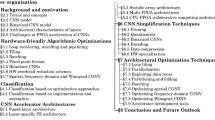Abstract
We propose the use of a deep convolutional neural network (DCNN) for fingerprint feature extraction and classification of wireless channels based on software defined radio. In the past, conventional classification schemes for wireless channels rely heavily on artificial extracting features, which limit their scalability. In this letter, we solve this problem based on DCNN and spectrogram. DCNN can automatically learn features and conduct classification using the gathered data. Our approach is tested in real-life environment. From the experiment, our DCNN model can extract the fingerprint features of wireless channels effectively. At the same time, it shows 96.46% accuracy for wireless channel classification.



Similar content being viewed by others
References
Pop MF, Beaulieu NC (2001) Limitations of sum-of-sinusoids fading channel simulators. IEEE Trans Commun 49:699–708
Zheng YR, Xiao C (2002) Improved models for the generation of multiple uncorrelated Rayleigh fading waveforms. IEEE Commun Lett 6:256–258
Chunli J, Zhenglin L (2016) Characteristic recognition of the fingerprints of wireless channel. In: Proceedings of IEEE 5th Asia-Pacific conference on antennas and propagation, pp 211–212
Chunli J, Zhenglin L (2016) Modeling of fingerprint characteristics of wireless communication channel. In: Proceedings of IEEE guidance, navigation and control conference, pp 1730–1734
Eskola M, Heikkila T (2016) Classification of radio channel disturbances for industrial wireless sensor networks. Ad Hoc Netw 42:19–33
Nengmei C, Xiaojing L (2017) Study of model of wireless channel classification based on algorithm of random forest. J Chongqing Univ Technol 31:134–140
Kailing Y, Yuli Z, Youming S (2016) Recognition of scenes based on characteristics of channel fingerprints in time-domain. J Military Commun Technol 37:72–76
Ferrari P, Flammini A, Marioli D et al (2010) On the implementation and performance assessment of a WirelessHART distributed packet analyzer. IEEE Trans Instrum Meas 59:1342–1352
Landolsi MA, Muqaibel AH (2016) UKF-based channel estimation and LOS/NLOS classification in UWB wireless networks. J Eng Res 4:86–102
Kim BK, Kang H-S, Park S-O (2017) Drone classification using convolutional neural networks with merged doppler images. IEEE Geosci Remote Sens Lett 14:38–42
Weng Q, Mao Z, Lin J (2017) Land-use classification via extreme learning classifier based on deep convolutional features. IEEE Geosci Remote Sens Lett 14:704–708
Zhou Y, Wang H (2016) Polarmetric SAR image classification using deep convolutional neural networks. IEEE Geosci Remote Sens Lett 13:1935–1939
Hinton G et al (2012) Deep neural networks for acoustic modeling in speech recognition. IEEE Signal Process Mag 29:82–97
Mikolov T, Deoras A, et al (2011) Strategies for training large scale neural network language models. In: Proceedings automatic speech recognition understanding, pp 196–201
LeCun Y, et al (1990) Handwritten digit recognition with a back-propagation network. In: Proceedings of advances in neural information processing systems, pp 396–404
LeCun Y, Kavukcuoglu K, Farabet C (2010) Convolutional networks and applications in vision. In: Proceedings of IEEE international symposium on circuits and systems, pp 253–256
Chen S, Wang H, Xu F, Jin Y-Q (2016) Target classification using the deep convolutional networks for SAR images. IEEE Trans Geosci Remote Sens 54:4806–4816
Mallat S (2016) Understanding deep convolutional networks. arXiv preprint arXiv: 1601.04920v1
Koushik J (2016) Understanding convolutional neural networks. arXiv preprint arXiv: 1605.09081v1
Hinton G, Srivastava N, et al (2012) Improving neural networks by preventing co-adaptation of feature detectors. arXiv preprint arXiv: 1207.0580
Bartko JJ (1966) The intraclass correlation coefficient as a measure of reliability. Psychol Rep 19:3–11
Hofmann W (1981) Remote sensing: the quantitative approach. IEEE Trans Pattern Anal Mach Intell 3:713–714
Wang J, et al (2010) Locality-constrained linear coding for image classification. In: Proceedings of IEEE conference on computer vision and pattern recognition, pp 3360–3367
Author information
Authors and Affiliations
Corresponding author
Rights and permissions
About this article
Cite this article
Yu, Y., Liu, F. & Mao, S. Fingerprint Extraction and Classification of Wireless Channels Based on Deep Convolutional Neural Networks. Neural Process Lett 48, 1767–1775 (2018). https://doi.org/10.1007/s11063-018-9800-1
Published:
Issue Date:
DOI: https://doi.org/10.1007/s11063-018-9800-1




